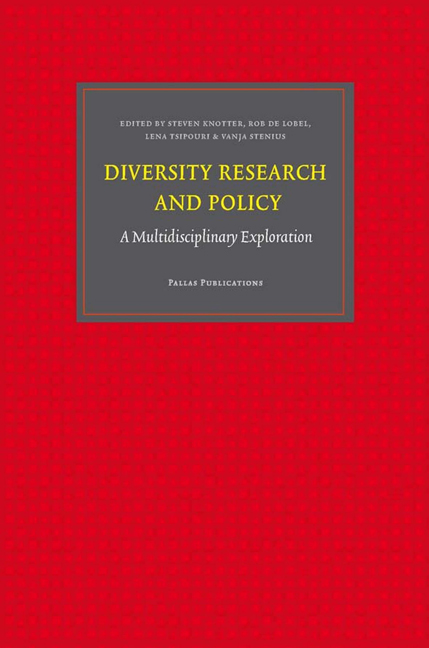Book contents
- Frontmatter
- Contents
- Acknowledgements
- 1 An Introduction
- 2 Diversity and Social Anthropology
- 3 Diversity and Sociology
- 4 Diversity and Criminology
- 5 Diversity and Ecology/Ecological Economics
- 6 Linguistic Diversity
- 7 Diversity and Architecture
- 8 Diversity and Urban Planning
- 9 Diversity and Economics
- 10 Diversity and Diversity Management in Business and Organisation Studies
- 11 Diversity and (Organisational) Psychology
- 12 Diversity and Law
- 13 Diversity and Public Policy
- 14 Conclusion
- About the Authors
- About the Reviewers
13 - Diversity and Public Policy
Published online by Cambridge University Press: 15 January 2021
- Frontmatter
- Contents
- Acknowledgements
- 1 An Introduction
- 2 Diversity and Social Anthropology
- 3 Diversity and Sociology
- 4 Diversity and Criminology
- 5 Diversity and Ecology/Ecological Economics
- 6 Linguistic Diversity
- 7 Diversity and Architecture
- 8 Diversity and Urban Planning
- 9 Diversity and Economics
- 10 Diversity and Diversity Management in Business and Organisation Studies
- 11 Diversity and (Organisational) Psychology
- 12 Diversity and Law
- 13 Diversity and Public Policy
- 14 Conclusion
- About the Authors
- About the Reviewers
Summary
Introduction
Public policy both implicitly and explicitly addresses diversity issues in a number of ways. Concretely, we can see public policy responses to diversity as governmental attempts – of action or inaction – to manage or deal with the issues, or sets of issues, that arise in different spheres of life. The policy itself is commonly embodied “in constitutions, legislative acts, and judicial decisions”. Some scholars define public policy as a system of “courses of action, regulatory measures, laws, and funding priorities concerning a given topic promulgated by a governmental entity or its representatives”. This section explores the real and potential policy measures and practical aspects of diversity in each of the scientific disciplines analysed in this volume.
While respecting the definition of diversity as elucidated in this volume, some nuances need to be taken into consideration in the analysis of policies. Public policy tends to address the generic concept of diversity at an abstract level; the approach to issues such as equal opportunities and coexistence, which is the foundation of many international, national and regional policies, may be seen as being philosophical in nature. Practical problems emerge with the translation of general principles into formal, or informal, rules. These problems relate to the way in which these principles are transformed into a concrete regulatory framework with an associated budget for the implementation, regulation or adoption of measures (incentives or sanctions). The practical application of a policy is, by necessity, more limited and restrictive than the rhetoric and general principles that serve as the policy's basis. This distinction between idea and reality highlights the importance of carefully considering both when studying public policy; both the societal and political context in which policy develops as well as the means by which it is applied are essential if we want to understand the relationship between public policy and diversity issues such as gender, migration, sexual orientation and religion.
Policy is not neutral, but derives from a set of values or ideals. The principle of respecting diversity is politically correct in Europe, and embedded in European culture. A quick look at the real world, however, demonstrates that issues of diversity are and continue to be contentious; independent of any rhetoric or generic values adopted by European or international bodies, individual policy interventions depend on citizens’ tolerance for diversity and the monetary/political costs of the intervention.
- Type
- Chapter
- Information
- Diversity Research and PolicyA Multidisciplinary Exploration, pp. 215 - 232Publisher: Amsterdam University PressPrint publication year: 2012



